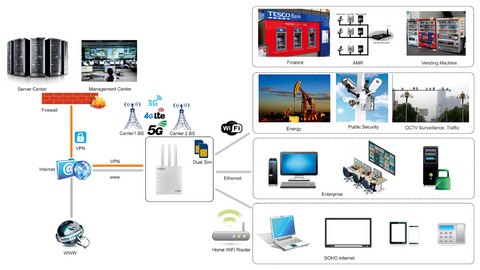
5g sim router - Can it make rural internet access easier?
Many households and businesses have become dependent on the Internet. The lack of reliable, high-speed internet connectivity still plagues many rural communities. Providing equitable access to essential resources and opportunities requires bridging this digital divide. Can emerging 5G wireless technology finally solve the rural internet dilemma? In particular, 5G routers with SIM card slots offer an intriguing new option for delivering broadband to remote regions. Let's explore whether these innovative devices make rural internet access significantly easier.
Rural Internet Challenge
Those living in urban areas have access to fiber-optic or cable internet. The majority of rural Americans live without 25 Mbps download speeds. Without adequate connectivity, these communities get left behind in the digital economy. Students struggle with homework and online classes. Telemedicine appointments become difficult or impossible. Farmers can't leverage precision agriculture tech. Solutions like satellite, fixed wireless, and DSL exist, but each has limitations in bandwidth, reliability, and latency. Many small towns and farms lack these options, even in the most remote areas. Laying miles of fiber or cable infrastructure is cost-prohibitive for sparse populations.
Exploring the potential of 5g technology in rural areas
The 5G technology could change everything. Next-generation wireless technology promises to boost speed, and capacity, and reduce lag time. 5G networks are projected to deliver typical download rates of 150-200 Mbps, with peak speeds up to 1 Gbps. That rivals or exceeds many cable and fiber connections. 5G achieves these speeds through higher-frequency radio waves, more cell sites, and smarter antennas. Carriers are rapidly building out 5G in urban and suburban markets. But could 5G also viably serve rural communities? Early indications suggest it handles large coverage zones across open spaces better than previous cellular generations.
What is a 5g sim router?
A 5G SIM router is a device that uses a cellular 5G network for internet connectivity instead of a wired connection. It contains a slot for inserting a 5G SIM card from your mobile carrier. It then establishes a high-speed broadband connection through the cellular network, just like a phone. But unlike a phone, it also serves as a full-fledged WiFi router. It broadcasts a private wireless signal throughout your home or office. Connecting your laptop, TV, gaming console, or other devices to the router's WiFi network delivers internet access. Essentially, it creates a personal 5G hotspot for all your equipment. Most 5G routers include standard router features like WiFi passwords, guest networks, parental controls, firewalls, and port forwarding for security, access control, and custom configurations. Ethernet ports allow wired connections if desired. Some models contain slots for 4G LTE SIM cards as a backup connectivity option when 5G signals are unavailable.
How 5g sim routers work?
When you insert a 5G SIM card from your wireless carrier, the router connects to the nearest 5G cellular network. No cable or phone lines are required. Performance will depend on the 5G coverage in your area and network capacity. In optimal conditions, you expect low latency and multi-megabit speeds. The router captures the 5G signal and amplifies it through its internal or external antenna array. It then broadcasts a local WiFi network from its antennas. Devices connect just as they would to any WiFi router by selecting the router's SSID and entering the password. With everything connected to the same WiFi network, the router handles traffic routing between devices and to/from the internet through the 5G connection. So streaming videos or browsing the web on your phone pulls data through the router from the cellular network instead of using your phone's native 5G connection.
 Best sim based router working architecture
Best sim based router working architecture
Why rural communities struggle with internet access?
Sparsely populated rural areas present some intrinsic connectivity challenges:
- Remote locations make cable and fiber build cost-prohibitive - Miles of lines must reach just a few customers.
- Line-of-sight obstructions like hills and trees complicate wireless services.
- Lack of cell towers restricts previous cellular options.
- Low projected revenues limit carrier buildouts. Upfront infrastructure investments are tough to recoup.
- Difficult terrain like mountains and valleys hinder signals.
- Distance between homes and businesses increases costs.
Those obstacles have relegated many country residents to patchy DSL, satellite with high latency, or unreliable fixed wireless. The emergence of 5G could shake up the rural internet dilemma.
Benefits of 5g sim routers
5G routers promise several advantages that address rural connectivity problems:
- 5g coverage in rural areas - Carriers are aggressively working to broaden 5G coverage into less populated zones. The technology broadcasts reliable signals across miles of open spaces.
- Speed and reliability improvements - Consistent 100+ Mbps speeds are game-changing for rural users struggling with sluggish DSL. 5G's low latency enhances real-time apps like video conferencing and telehealth. Reliability improves through dedicated spectrum and network upgrades.
- Easier setup than wired broadband - It is easy to connect to 5G using only a SIM card. There is no need to wait for an installer to run cable or fiber. Portability allows users to get online from almost anywhere with 5G signals.
- Affordability comparisons to wired internet - While 5G router hardware costs more upfront, monthly 5G data plans are dropping in price and compare favorably to pricy satellite and rural cable packages.
Comparison between 5g sim router and normal router
|
Feature |
Normal Router |
|
|
Internet Connection |
Cellular 5G network |
Wired broadband (cable, DSL, fiber optic)
|
|
Speed |
50-200+ Mbps (peak 1 Gbps) |
Up to 1 Gbps (fiber optic) |
|
Latency |
Low, 10-30 ms |
Low, <30 ms (fiber optic)
|
|
Mobility |
Portable, works anywhere with 5G signal |
Stationary, requires fixed line installation |
|
Availability |
Dependent on 5G coverage area |
Available anywhere cable/fiber connections exist
|
|
Setup |
Insert SIM card and power on |
Professional installation of lines and equipment
|
|
Connection Consistency |
Can suffer with network congestion |
Very consistent speeds and reliability |
|
Data Usage Costs |
Monthly data plans like cell phone |
Flat unlimited data on wired plans |
|
Security |
Standard wireless security protocols |
Physical line security, standard wireless protocols
|
|
Number of Wired Connections |
1 Ethernet LAN port |
2 Ethernet LAN ports on router |
|
Wi-Fi Range |
50-100 ft. indoors, less through walls |
50-150 ft. indoors depending on router model
|
Will it replace satellite and WISP services?
5G routers won't render satellite internet obsolete. Geostationary satellites reach locations too remote for any terrestrial coverage. However, the reduced latency of 5G makes it far superior for real-time apps. Some rural users combine the two - satellite for backup but 5G for general use. Fixed wireless ISPs that utilize point-to-point microwave signals will retain advantages over 5G for the most rugged terrain. However, their capacity is limited compared to the advanced cellular infrastructure. For many rural markets, 5G coverage and performance is sufficient to eliminate the need for those alternative options.
Conclusion
While the 5G rollout is still ramping up globally, the future looks promising for bridging digital divides. Expanding 5G to rural communities could drive innovations in remote education, telemedicine, e-commerce, and more. This potential is propelling interest from carriers and government programs alike. Additional solutions like low-orbit satellites, drones, and balloons could someday work alongside 5G to provide blanket rural coverage.


















